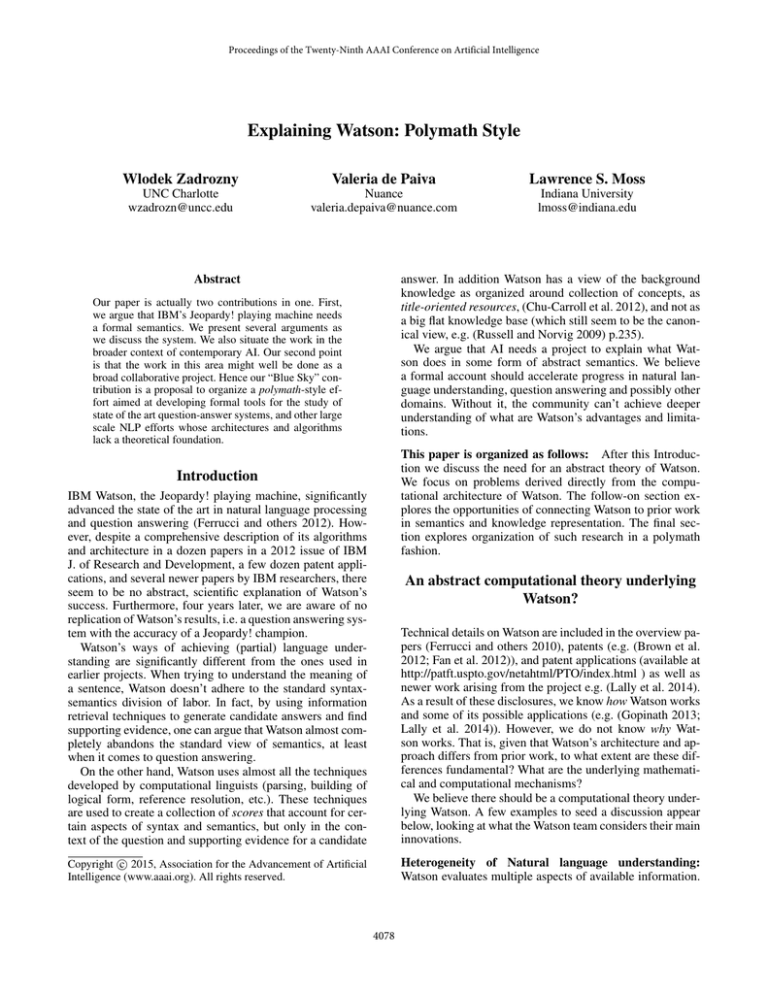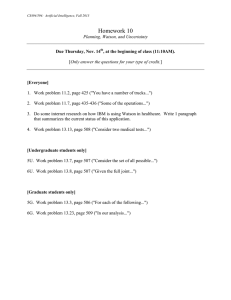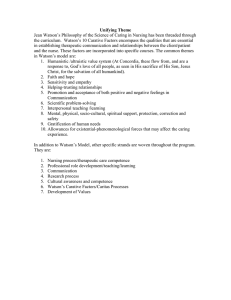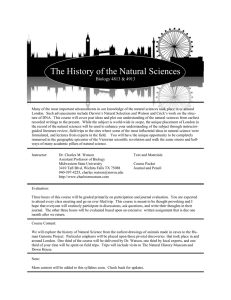
Proceedings of the Twenty-Ninth AAAI Conference on Artificial Intelligence
Explaining Watson: Polymath Style
Wlodek Zadrozny
Valeria de Paiva
Lawrence S. Moss
UNC Charlotte
wzadrozn@uncc.edu
Nuance
valeria.depaiva@nuance.com
Indiana University
lmoss@indiana.edu
Abstract
answer. In addition Watson has a view of the background
knowledge as organized around collection of concepts, as
title-oriented resources, (Chu-Carroll et al. 2012), and not as
a big flat knowledge base (which still seem to be the canonical view, e.g. (Russell and Norvig 2009) p.235).
We argue that AI needs a project to explain what Watson does in some form of abstract semantics. We believe
a formal account should accelerate progress in natural language understanding, question answering and possibly other
domains. Without it, the community can’t achieve deeper
understanding of what are Watson’s advantages and limitations.
Our paper is actually two contributions in one. First,
we argue that IBM’s Jeopardy! playing machine needs
a formal semantics. We present several arguments as
we discuss the system. We also situate the work in the
broader context of contemporary AI. Our second point
is that the work in this area might well be done as a
broad collaborative project. Hence our “Blue Sky” contribution is a proposal to organize a polymath-style effort aimed at developing formal tools for the study of
state of the art question-answer systems, and other large
scale NLP efforts whose architectures and algorithms
lack a theoretical foundation.
This paper is organized as follows: After this Introduction we discuss the need for an abstract theory of Watson.
We focus on problems derived directly from the computational architecture of Watson. The follow-on section explores the opportunities of connecting Watson to prior work
in semantics and knowledge representation. The final section explores organization of such research in a polymath
fashion.
Introduction
IBM Watson, the Jeopardy! playing machine, significantly
advanced the state of the art in natural language processing
and question answering (Ferrucci and others 2012). However, despite a comprehensive description of its algorithms
and architecture in a dozen papers in a 2012 issue of IBM
J. of Research and Development, a few dozen patent applications, and several newer papers by IBM researchers, there
seem to be no abstract, scientific explanation of Watson’s
success. Furthermore, four years later, we are aware of no
replication of Watson’s results, i.e. a question answering system with the accuracy of a Jeopardy! champion.
Watson’s ways of achieving (partial) language understanding are significantly different from the ones used in
earlier projects. When trying to understand the meaning of
a sentence, Watson doesn’t adhere to the standard syntaxsemantics division of labor. In fact, by using information
retrieval techniques to generate candidate answers and find
supporting evidence, one can argue that Watson almost completely abandons the standard view of semantics, at least
when it comes to question answering.
On the other hand, Watson uses almost all the techniques
developed by computational linguists (parsing, building of
logical form, reference resolution, etc.). These techniques
are used to create a collection of scores that account for certain aspects of syntax and semantics, but only in the context of the question and supporting evidence for a candidate
Technical details on Watson are included in the overview papers (Ferrucci and others 2010), patents (e.g. (Brown et al.
2012; Fan et al. 2012)), and patent applications (available at
http://patft.uspto.gov/netahtml/PTO/index.html ) as well as
newer work arising from the project e.g. (Lally et al. 2014).
As a result of these disclosures, we know how Watson works
and some of its possible applications (e.g. (Gopinath 2013;
Lally et al. 2014)). However, we do not know why Watson works. That is, given that Watson’s architecture and approach differs from prior work, to what extent are these differences fundamental? What are the underlying mathematical and computational mechanisms?
We believe there should be a computational theory underlying Watson. A few examples to seed a discussion appear
below, looking at what the Watson team considers their main
innovations.
c 2015, Association for the Advancement of Artificial
Copyright Intelligence (www.aaai.org). All rights reserved.
Heterogeneity of Natural language understanding:
Watson evaluates multiple aspects of available information.
An abstract computational theory underlying
Watson?
4078
Figure 1: Watson architecture. A question is answered by generating candidate answers from document titles, finding supporting
evidence, and evaluating the evidence using over 400 scorers. Source: Wikipedia
ically? What if answers need to be synthesized from pieces
of information coming from different documents?
Document search with titles serving as answers can be
contrasted with steps in QA before Watson: Question classification (who, what, when, how big,. . . ); passage search to
find passages with matching terms or relations; interpretation (typically using shallow or partial compositional semantics); matching relations (’unification’) to extract an answer;
and estimating the likelihood of the answer being correct.
(See e.g. (Moldovan et al. 2003b))
This is done by retrieving dozens of paragraphs of text with
supporting evidence, using multiple programs to score the
evidence, and synthesizing the final score (Fig.1). In other
words, Watson uses heterogeneous sources of information,
creates multiple representations, and evaluates using different kinds of scorers.
A recent paper (Schütze 2013) argues that semantics
should be heterogeneous. It also contains the following passage about Watson: “My impression is that in these systems
interaction is implemented in an ad-hoc and manually optimized way. For example, the IBM question answering system Watson (Ferrucci et al., 2010) has many heterogeneous
modules that each contribute information useful for solving
a Jeopardy task. The final design of the components that integrate this information into the Jeopardy! answer seems to
have been the result of careful and time-intensive fine tuning.
(italics ours).
As we see it, Watson’s formal semantics have yet to be
formulated. And proposing a semantics would help answer
questions already asked by others.
Semantics of the deferred type evaluation Another Watson innovation is deferred type evaluation (Fan et al. 2012)
(US Patent 8332394, 2012). Again, we ask whether it is fundamental or a piece of lucky heuristics? An anecdotal argument for its fundamental value can cobbled from a set of
examples in the patent. The examples show the creativity
of language precludes enumeration of all types of answers.
Consider the question “which 19th century US presidents
were assassinated?” To answer it, one can easily find a list of
US Presidents (and use it as an ontology/set of types), but we
are unlikely to find a list of 19th century (American) presidents. (For that matter, we are unlikely to find a list of presidents killed in a theater.) Therefore Watson’s strategy is to
answer a query by waiting until an “answer type” (i.e., a descriptor) is determined and a candidate answer is provided.
The answer type is not required to belong to a predetermined
ontology, but is viewed as lexical/grammatical item. Then, a
search is conducted to look for evidence that the candidate
answer has the required answer type. The match of candidate answer with the answer type is determined by a set of
scorers using e.g. a parser, a semantic interpreter or a simple pattern matcher). We ask whether this procedure can be
formalized and evaluated theoretically.
Role of search in question answering As an initial step
in Watson, primary search generates a few hundred candidate answers consisting of the title fields of matching documents (see Fig. 1). This works well for Jeopardy!-style
questions, where many answers are entities with entries in
Wikipedia or other encyclopedic sources. However we don’t
know how applicable this strategy is for question types other
than those in Jeopardy! Can any text collection be organized
(by a computational procedure) in such a way that candidate
answers may be generated by search? Under what conditions
can we say that a piece of text is about a given topic? Can
Watson’s title-oriented data organization be created dynam-
4079
Semantics of scoring Thirdly, Watson uses multiple scorers to estimate degrees of match between a question and a
candidate answer along a few hundred dimensions. Many
of the scorers are evaluating quantities familiar from computational semantics (e.g. matching of predicate-argument
structures). But some are not. Does this strategy of employing multiple scorers lead to a dialogue-like view of meaning? Such an alternative would generate candidate interpretations, then find supporting evidence, and finally evaluate
the candidates. Meaning would reside in this process. But
what further implications does such a semantics have? And
returning to Watson, is this use of multiple scorers really
a deep contribution, or is an engineering feat but nothing
more?
sure the size and kind of its collection of data and not simply the worst-case, or average-case, case complexity of inference.
We believe that a thorough adaptation of Automated Theorem Proving to KR scenarios would be interesting. In fact
this adaptation has already been started in the form of the
“track/division” called ‘Large Theory Base’ (LTB) of the
CASC (CADE ATP System Competition). However this
competition is restricted to theorem proving systems using
the TPTP (Thousands of Problems for Theorem Provers)
language. Thus this adaptation has been, so far, less ambitious, and frankly less “blue sky” than what we want to do.
Given that our intent is more experimentation, less competition, we would like to try different provers with different sets
of KR languages, aiming for compatibility of formalisms
and hidden synergies between modules.
Recognizing that logical inference is necessary to build
NL representations, as well as necessary to reason about information encoded in representations aleady in the system,
and that the reasoning with representations already created
can be much simpler, we would like to investigate tradeoffs between these two sets of logical inferences. The traditional mechanisms of over-simplification of parts of processing can be useful here. One should be able to reason easily
with representations, if we concentrate the difficult issues of
creating representations in some kind of blackbox that we
can instantiate with different formalisms, be they description logics, first-order logics or higher-order logics (Nigam
and de Paiva 2014). Perhaps instead we want to stay as close
as possible to Natural Language, using one of the several
versions of Natural Logic (cf., e.g.(Moss 2015)) recently at
our disposal. Recent work on recognizing textual entailment
(RTE) (Dagan et al. 2010; Sammons 2015) ought to be helpful as a way of testing formalisms and their inferential capabilities.
Questions
We now go into more detail about the other broad kinds of
questions which we hope to address.
Which kind of formal semantics? The Watson team did
not pay much attention to formal natural language semantics. However, they incorporated most of the known computational tools. The question is why this combination of
tools worked better than e.g. (Moldovan et al. 2003b), who
showed that paying more attention to formal semantics can
significantly improve QA results, that is “the overall performance of QA systems is directly related to the depth of
NLP resources”, and “the prover boosts the performance of
the QA system on TREC questions by 30%” (Moldovan et
al. 2003a). Similar claims about improvements provided by
logical tools are found in (MacCartney and Manning 2009)
At this point is not clear that Watson style of NLP can even
be cast in a formal semantics.
How can large systems like Watson integrate statistical and symbolic methods? Along with many other researchers, we believe that both statistical methods and structural ones have their own place in computational and formal linguistics. The question of integrating these two approaches is of interest to many in the field. We know on the
architectural level how Watson carries out this integration
(from patents and the journal collection). However what are
its foundational aspects? For example, what would be a natural formalism to describe it? How would it be related to other
proposals in the field such as the BLOG language (Milch et
al. 2007) combining probability with logic?
What does Big Data do for Watson? And what it does
not do? We would like to know to what extent Watson’s
success is based on the large amount of training data: 200K
available questions with answers, and about 50K of them
used for training and testing. To what extent it is dependent
on the highly parallel aspect of its scoring system? Parallelism was essential given the amount of background textual
knowledge Watson relied on. But was less important when
the background knowledge was much smaller. How do these
factors interact with each other, with available background
knowledge, and with deeper semantic processing? What are
the underlying mechanisms of these interactions?
What are the appropriate foundations for automated deduction when reasoning for common sense? One avenue of investigation could be to adapt “automated deduction” from the more mathematical setting of interactive theorem provers such as Coq and HOL to the more AI-oriented
setting of automatic question-answering. In fields like KR,
databases (where the necessary assumptions for proofs need
to be found) are too huge, but shallow. Similarly, ‘proofs’
only need a few inference steps, but finding the correct axioms/theories is the difficult part. Hence, for such fields, the
appropriate notion of ‘complexity’ will be different from the
one from traditional theoretical computer science. Complexity for question answering systems should somehow mea-
Prior Work in the Area
There seem to be no scholarly work on semantics of Watson.
Our repeated searches on Google Scholar yield zero results
addressing the problem. IBM Watson is mentioned in very
few relevant contexts. For example, there are only 27 entries for “watson ibm jeopardy ‘formal semantics’. For other
searches the result is lower (Sept 26 2014, excluding citations). However, none of the papers presented a formal view
of the complete Watson system. On the other hand, there are
some papers to build on, including (Noy and McGuinness
4080
Additional Possible Targets for New Theories
2013; Iyyer et al. 2014).
As mentioned above we believe there are opportunities for
interesting research on ideas and techniques inspired by
Watson. In particular, we mentioned a “heterogeneous” semantics of NL and related to it semantics of scoring; topicality of knowledge (i.e. title- or topic-oriented organization
of knowledge), and deferred type evaluation. There are obvious connections between these problems and the domains of
natural language processing and knowledge representation.
But there additional areas that can be targeted for formalization, or even formulation of semi-formal hypotheses of
what is going on. (We imagine there would be also experimental work in these targeted areas). Thus, for example, we
would like to know more about the trade-off between adding
semantics to candidate answers search vs. deeper semantics
of supporting passage retrieval vs. deeper semantics of scoring. This has intuitive connections to the work on “faceted
search” (Tunkelang 2009) and “semantic search” (Hendler
2010), since many scorers could be in principle used to create facets. And yet would probably be different, because the
Watson team showed there isn’t one ontology (or set of topics) covering all types of Jeopardy! questions ,
The Watson team used almost all known NLP techniques.
We can ask whether there are any types of natural language understanding (NLU) components are NOT useful for
Watson-like tasks or architectures? Or, in other words, what
are the trade-offs between different classes of components.
For example can adding additional types of faceted search
decrease the need for scorers (keeping the accuracy constant).
We are not aware of a theory of multi-stage scoring used
in Watson(Agarwal et al. 2012), nor of the mathematics of
composing Machine Learning (ML) systems, with very large
numbers of scorers of different types (e.g. a group scoring quality of sources, and another group providing variants of predicate argument structures). How different can or
should the ML systems be? How does one decide on the optimal number of scorers? This might be connected to work
on structure learning and ensemble learning (e.g. (Cortes,
Kuznetsov, and Mohri 2014; Mendes-Moreira et al. 2012)),
but we are not aware of an explicit theory.
Polymath Projects
We propose to organize a polymath project, an online massively cooperative blog (see (Wikipedia 2014; Gowers et
al. 2014)). The name comes from mathematics, where Tim
Gowers has led nine projects, including some where actual
theorems have been proved. As the New Scientist notes in
their editorial “Mathematics becomes more sociable” of 05
May 2011, “The first analysis of the Polymath project concludes that online collaborations set up in the right way can
solve problems with unprecedented speed and efficiency.”
Of course, what we propose here is not the solution of concrete mathematical problems but rather the initiation of a
research area. That is, the results would be a set of new concepts and ideas (all informal), and also formal definitions,
test results, problems; in addition, we feel that the much of
the work in this area will involve simulation and the borrowing of ideas and programs from other areas of AI, Cognitive
Science, Computational Linguistics, and beyond.
We imagine we would moderate and seed the discussion,
and contribute to solving the problems, but the problem(s)
will be addressed by the whole community. The majority of
insights could be provided by the community of researchers
interested in the topic.
Experimenting in Watson Polymath
We imagine the Watson Polymath project to have at least
two dimensions: The first would be discussion of new ideas,
and maintenance of competing theories, e.g. in the form of a
wiki. Second, because we are dealing with the topic of language understanding under a broad conception, there must
be an experimental component. We already presented some
starting points for the former, so let’s discuss the resources
for experimentation.
As mentioned above, IBM has been publishing a lot about
Watson, but the basic idea behind Watson is that you should
be able to plug-and-play modules, and perform experimental evaluations. Thus we imagine systematically evaluating
selected combinations of open source NLP resources such
as parsers and entity extractors. Lately, IBM has begun to
allow access to Watson APIs (Sudarsan 2014) for selected
groups (e.g. entrepreneurs, faculty and students) (Sudarsan
2014). In addition, it has been shown in classes at Columbia
University (Gliozzo et al. 2013), and at Rensselear Polytechnic (RPI) (Hendler 2013; Hendler and Ells 2014), that selected portions of the Watson pipeline can be reconstructed.
More recently, in Spring of 2014, almost complete simulation of the Watson architecture and several textual resources were created in the class on “Semantic technologies in IBM Watson” at UNC Charlotte (Zadrozny and Gallagher 2015). This class developed and/or used knowledge
sources in TREC format (versions of Wikipedia, Wiktionary,
Wikiquotes, etc.), Eclipse workspaces allowing experiments
with various search engines and plug in NLP components.
links to experiment evaluation software, and documentation.
Conclusions
We argued there is need for an abstract explanation of the
Watson success. In addition, we propose to work on this
problem in a polymath-style project, that is, as an open collaborative project. An argument can be made for this approach both based on the success of the original Polymath
projects, and from general trends towards open science and
open research (e.g. (Nielsen 2012)). Given Watson’s importance and publicity, there’s a good chance that such a project
would be successful; we expect both quality scientific papers
and new algorithms. With the partial opening of the Watson
APIs by IBM, we can even hope to influence the development of applications in not so distant future.
4081
References
MacCartney, B., and Manning, C. D. 2009. An extended
model of natural logic. In Proceedings of the eighth international conference on computational semantics, 140–156.
Association for Computational Linguistics.
Mendes-Moreira, J. a.; Soares, C.; Jorge, A. M.; and Sousa,
J. F. D. 2012. Ensemble approaches for regression: A survey.
ACM Comput. Surv. 45(1):10:1–10:40.
Milch, B.; Marthi, B.; Russell, S.; Sontag, D.; Ong, D. L.;
and Kolobov, A. 2007. 1 blog: Probabilistic models with
unknown objects. Statistical relational learning 373.
Moldovan, D.; Clark, C.; Harabagiu, S.; and Maiorano, S.
2003a. Cogex: A logic prover for question answering. In
Proceedings of the 2003 Conference of the North American
Chapter of the Association for Computational Linguistics on
Human Language Technology - Volume 1, NAACL ’03, 87–
93. Stroudsburg, PA, USA: Association for Computational
Linguistics.
Moldovan, D.; Paşca, M.; Harabagiu, S.; and Surdeanu, M.
2003b. Performance issues and error analysis in an opendomain question answering system. ACM Trans. Inf. Syst.
21(2):133–154.
Moss, L. S. 2015. Natural logic. In Handbook of Contemporary Semantic Theory, Second Edition. Wiley. 761–802.
Nielsen, M. 2012. Reinventing Discovery: the New Era of
Networked Science. Princeton University Press.
Nigam, V., and de Paiva, V. 2014. Towards a rewriting
framework for textual entailment. In Pre-proceedings of the
9th Workshop on Logical and Semantic Frameworks, with
Applications, Brasilia, Brazil, Sept 2014.
Noy, N., and McGuinness, D., eds. 2013. Research Challenges and Opportunities in Knowledge Representation, Final Report on the 2013 NSF Workshop on Research Challenges and Opportunities in Knowledge Representation.
NSF.
Russell, S., and Norvig, P. 2009. Artificial intelligence: A
modern approach. Prentice Hall.
Sammons, M. 2015. Recognizing textual entailment. In
Handbook of Contemporary Semantic Theory, Second Edition. Wiley. 711–757.
Schütze, H. 2013. Two maps of Manhattan. In King, T. H.,
and de Paiva, V., eds., From Quirky Case to Representing
Space: Papers in Honor of Annie Zaenen. Center for Study
Language and Information, Stanford.
Sudarsan, S. 2014. Creating cognitive applications powered
by IBM Watson: Getting started with the API.
Tunkelang, D. 2009. Faceted Search. Synthesis Lectures
on Information Concepts, Retrieval, and Services. Morgan
& Claypool Publishers.
Wikipedia. 2014. Polymath project. http:// en.wikipedia.
org/ wiki/ Polymath Project.
Zadrozny, W., and Gallagher, S.and Shalaby, W. 2015. Simulating IBM Watson in the Classroom. to appear in: Proc.
ACM SIGCSE 2015 6pp.
Agarwal, A.; Raghavan, H.; Subbian, K.; Melville, P.;
Lawrence, R. D.; Gondek, D. C.; and Fan, J. 2012. Learning to rank for robust question answering. In Proceedings of
the 21st ACM International Conference on Information and
Knowledge Management, CIKM ’12, 833–842. New York,
NY, USA: ACM.
Brown, E.; Ferrucci, D.; Lally, A.; and Zadrozny, W. W.
2012. System and method for providing answers to questions. US Patent 8,275,803.
Chu-Carroll, J.; Fan, J.; Schlaefer, N.; and Zadrozny, W.
2012. Textual resource acquisition and engineering. IBM
Journal of Research and Development 56(3.4):4:1–4:11.
Cortes, C.; Kuznetsov, V.; and Mohri, M. 2014. Ensemble
methods for structured prediction. In Proceedings of the 31st
International Conference on Machine Learning (ICML-14),
1134–1142.
Dagan, I.; Dolan, B.; Magnini, B.; and Roth, D. 2010.
Recognizing textual entailment: Rational, evaluation and
approaches–erratum.
Natural Language Engineering
16(01):105–105.
Fan, J.; Ferrucci, D.; Gondek, D. C.; and Zadrozny, W. W.
2012. System and method for providing questions and answers with deferred type evaluation. US Patent 8,332,394.
Ferrucci, D., et al. 2010. Building Watson: An overview of
the DeepQA project. AI Magazine 31(3).
Ferrucci, D. A., et al. 2012. Introduction to ”This is Watson”. IBM J. RES. and DEV 56(3).
Gliozzo, A.; Biran, O.; Patwardhan, S.; and McKeown, K.
2013. Semantic technologies in IBM WatsonTM. ACL 2013,
http://www.aclweb.org/anthology/W13-3413 85.
Gopinath, R. 2013. Watson goes global: How IBM
Research
India is advancing cognitive computing.
http://asmarterplanet.com/blog/2013/10/watson-goesglobal-how-ibm-research-india-is-advancing-cognitivecomputing.html.
Gowers, T.; Kalai, G.; Nielsen, M.; and Tao, T. 2014. The
polymath blog. http:// polymathprojects.org/ .
Hendler, J., and Ells, S. 2014. Retrieved September 03 2014
from http://www.slideshare.net/jahendler/why-watson-wona-cognitive-perspective?next slideshow=1.
Hendler, J. 2010. Web 3. 0: The dawn of semantic search.
Computer 43(1):77–80.
Hendler, J. 2013. Watson at RPI. Retrieved September
03 2014 from http://www.slideshare.net/jahendler/watsonsummer-review82013final.
Iyyer, M.; Boyd-Graber, J.; Claudino, L.; Socher, R.; and III,
H. D. 2014. A neural network for factoid question answering
over paragraphs. In Proceedings of EMNLP 2014.
Lally, A.; Bagchi, S.; Barborak, M. A.; Buchanan, D. W.;
Chu-Carroll, J.; Ferrucci, D. A.; Glass, M. R.; Kalyanpur,
A.; Mueller, E. T.; Murdock, J. W.; Patwardhan, S.; Prager,
J. M.; and Welty, . C. A. 2014. Watsonpaths: Scenariobased question answering and inference over unstructured
information.
4082



